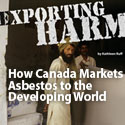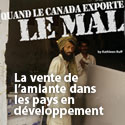Kathleen Ruff, RightOnCanada
In a powerful decision, a New York appeal court has found that eleven articles, published in scientific journals, were potentially part of a crime-fraud. The articles, financed by Georgia-Pacific, were intended to cast doubt on the capability of chrysotile asbestos to cause cancer.
In a unanimous decision, five judges of a New York Appeal Court ruled (1) on June 6, 2013 that Georgia-Pacific must allow an in camera (private) review of documents and raw data related to eleven published research studies, funded by Georgia-Pacific, concerning the health effects of the company’s asbestos-containing joint compound (a product used in construction).
The appellate court rejected Georgia-Pacific’s argument that the documents were protected by attorney-client privilege and should therefore not be disclosed. Normally, attorney-client privilege is treated as sacrosanct in the U.S. In exceptional circumstances, however, that privilege can be overruled. The appeal judges decided that this was an exceptional situation and upheld an earlier court decision which ruled that an in camera review of the documents should be held in order to determine whether the crime-fraud exception to the attorney-client privilege applied.
The five judges noted that the crime-fraud exception encompasses “a fraudulent scheme, an alleged breach of fiduciary duty or an accusation of some other wrongful conduct'”.
“Advice in furtherance of a fraudulent or unlawful goal cannot be considered sound. Rather advice in furtherance of such goals is socially perverse, and the client’s communications seeking such advice are not worthy of protection”.
Georgia-Pacific (GP) funded these studies in 2005 to aid in its defense of asbestos-related lawsuits.
The court noted that the studies were intended to cast doubt on the capability of chrysotile asbestos to cause cancer and that the authors did not disclose that GP’s counsel participated in lengthy discussions of the manuscripts and suggested revisions.
The articles were published in the following scientific journals: Inhalation Toxicology, the Journal of Occupational & Environmental Hygiene, the Annals of Occupational Hygiene, Risk Analysis (see list of articles below). The articles were untruthfully presented as being independent, bona fide research.
The court noted that, despite the extensive participation by GP’s in-house counsel, none of the articles disclosed that the company’s lawyer had reviewed the manuscripts before they were submitted for publication. Two articles falsely stated that “[GP] did not participate in the design of the study, analysis of the data, or preparation of the manuscript.”
David Bernstein’s claim that his research was “sponsored” by a grant from Georgia-Pacific was false.
No grant existed and Bernstein was hired by Georgia-Pacific on an hourly rate.
The court stated that, for three articles lead-authored by David M. Bernstein, Ph.D., and co-authored by Stewart Holm, the only disclosure was that the research was “sponsored” or “supported” by a grant from GP. The articles did not disclose that Holm was specially employed by GP for the asbestos litigation or that he reported to GP’s in-house counsel.
Furthermore, stated the court, there were no grant proposals, and Dr. Bernstein was hired by GP on an hourly basis. Nor did the articles disclose that Dr. Bernstein has been a GP expert witness in New York County asbestos litigation since 2009, that he had testified as a defense expert for Union Carbide Corporation in asbestos litigation, or that he had been paid by, and spoken on behalf of, the Chrysotile Institute, the lobbying arm of the Quebec chrysotile mining industry.
While Bernstein presents himself as an independent scientist, he has, in fact, for decades been financed by and worked closely with the asbestos industry around the world. In August 2012, for example, Bernstein was brought in by the Brazilian asbestos lobby to testify before the Supreme Court of Brazil in support of the industry’s position that chrysotile asbestos should not be banned.
Although GP belatedly endeavored to address the inadequacies of certain of its disclosures, its corrections failed to acknowledge its in-house counsel’s participation and did not make clear that Dr. Bernstein’s testimony as an expert witness preceded the publication of the first GP reformulated joint compound article in 2008, noted the appeal court.
The foregoing constitutes a sufficient factual basis, stated the appellate judges, for a finding that the relevant communications could have been in furtherance of a fraud, and the motion court properly confirmed the recommendation directing in camera review of the internal documents. The judges cited the earlier court’s remark that it is of concern that GP’s in-house counsel would be so intimately involved in supposedly objective scientific studies, especially in light of GP’s disclosures denying such participation.
Georgia-Pacific should not be allowed to use its experts’ conclusions as a sword by seeding the scientific literature with GP-funded studies, while at the same time using the privilege as a shield by withholding the underlying raw data that might be prone to scrutiny by the opposing party and that may affect the veracity of its experts’ conclusions.
The appeal judges cited a court ruling that “Large corporations often invest strategically in research agendas whose objective is to develop a body of scientific knowledge favorable to a particular economic interest or useful for defending against particular claims of legal liability”.
The judges also cited the judgment in the case of In re American Tobacco Co: “The publication of [research] findings and conclusions invites use by persons whom the findings favor and invites reliance by the finders of fact. The public has an interest in resolving disputes on the basis of accurate information”. In the present case, noted the judges, GP commissioned the studies in anticipation of litigation and has admitted that “[a]t an appropriate time and after their publication is complete, GP plans to introduce the results of the studies in litigation.”
The appeal court stated that principles of fairness require more complete disclosure, and GP should not be allowed to use its experts’ conclusions as a sword by seeding the scientific literature with GP-funded studies, while at the same time using the privilege as a shield by withholding the underlying raw data that might be prone to scrutiny by the opposing party and that may affect the veracity of its experts’ conclusions.
(1) In re New York City Asbestos Litigation, Weitz & Luxenberg P.C., Plaintiffs-Respondents, v Georgia-Pacific LLC, Defendant-Appellant, SUPREME COURT, APPELLATE DIVISION, June 6, 2013
What is the responsibility of the scientific journals that published this dishonest research?
The four scientific journals that published the eleven articles are: Inhalation Toxicology (four articles), the Journal of Occupational & Environmental Hygiene (four articles), the Annals of Occupational Hygiene (two articles), Risk Analysis (one article).
These four scientific journals were presumably duped so that they unwittingly published, as if it were legitimate, independent scientific research, articles that were, in reality, asbestos industry manipulated, controlled and financed. Thus the journals unknowingly deceived and failed their readers.
It behooves these four scientific journals to prominently publish an apology to their readers, remove the tainted articles from their websites and archives and replace them with a statement explaining that these articles have been removed because the articles were dishonestly presented as being legitimate, independent scientific research, when, in fact, the articles were asbestos industry manipulated, controlled and financed and were potentially part of a crime-fraud.
It is to be hoped that scientists and health advocates, who care about the integrity of science and the protection of health, contact the four journals and make this request and make public the response they receive.
LIST OF THE ELEVEN TAINTED ARTICLES
*Brorby, Sheehan, Berman, Greene and Holm, Re-Creation of Historical Chrysotile-Containing Joint Compounds, INHALATION TOXICOLOGY, 20:1043-1053 (2008)
*Bernstein, Donaldson, Decker, Gaering, Kunzendorf, Chevalier and Holm, A Biopersistence Study following Exposure to Chrysotile Asbestos Alone or in Combination with Fine Particles, INHALATION TOXICOLOGY, 20: 1009-1028 (2008)
*Bernstein, Rogers, Sepulveda, Donaldson, Schuler, Gaering, Kunsendorf, Chevalier and Holm, The Pathological Response and Fate in the Lung and Pleura of Chrysotile in Combination with Fine Particles Compared to Amosite Asbestos Following Short-Term Inhalation Exposure: Interim Results, INHALATION TOXICOLOGY, 22 (11): 937-962 (2010)
*Bernstein, Rogers, Sepulveda, Donaldson, Schuler, Gaering, Kunzendorf, Chevalier and Holm, Quantification of the Pathological Response and Fate in the Lung and Pleura of Chrysotile in Combination with Fine Particles Compared to Amosite-Asbestos Following Short-Term Inhalation Exposure, INHALATION TOXICOLOGY, 23(7): 372-391 (2011)
*Brorby, Sheehan, Berman, Bogen and Holm, Potential Artifacts Associated with Historical Preparation of Joint Compound Samples and Reported Airborne Asbestos Concentrations, J. OCCUP. AND ENVIRON. HYG., 8: 271-278 (2011)
*Sheehan, Brorby, Berman, Bogen and Holm, Chamber for Testing Asbestos-Containing Products: Validation and Testing of a Re-Created Chrysotile-Containing Joint Compound, ANN. OCCUP. HYG., 55(7) 797- 809 (2011)
*Simmons, Jones and Boelter, Factors Influencing Dust Exposure: Finishing Activities in Drywall Construction, J. OCCUP. AND ENVIRON. HYG., 8: 324-336 (2011)
*Jones, Simmons and Boelter, Development and Evaluation of a Semi-Empirical Two Zone Dust Exposure Model for a Dusty Construction Trade, J. OCCUP. AND ENVIRON. HYG., 8: 337-348 (2011)
*Jones, Simmons & Boelter, Comparing Two-Zone Models of Dust Exposure, J. OCCUP. AND ENVIRON. HYG., 8: 513-519 (2011)
*Berman, Brorby, Sheehan, Bogen and Holm, More on the Dynamics of Dust Generation: The Effects of Mixing and Sanding Chrysotile, Calcium Carbonate, and Other Components on the Characteristics of Joint-Compound Dusts, ANN. OCCUP. HYG., 56(7):852-867 (2012)
*Brorby, Sheehan, Berman, Bogen and Holm, Exposures from Chrysotile-Containing Joint Compound: Evaluation of New Model Relating Respirable Dust to Fiber Concentrations, RISK ANALYSIS 2012



Fri, Jun 7, 2013
Asbestos